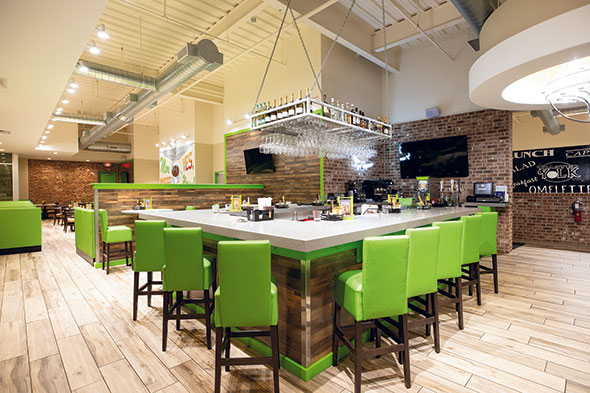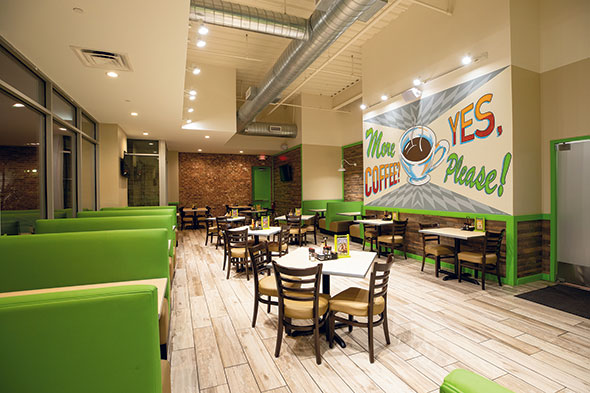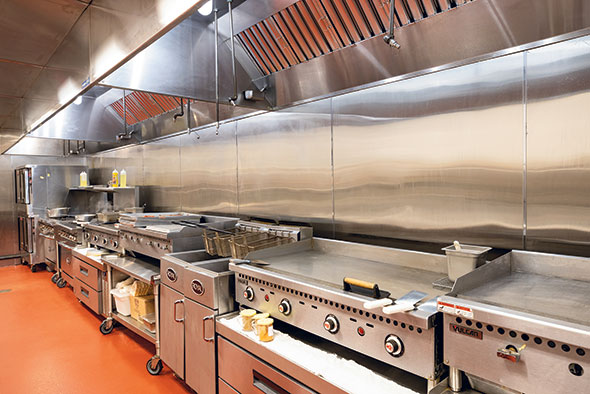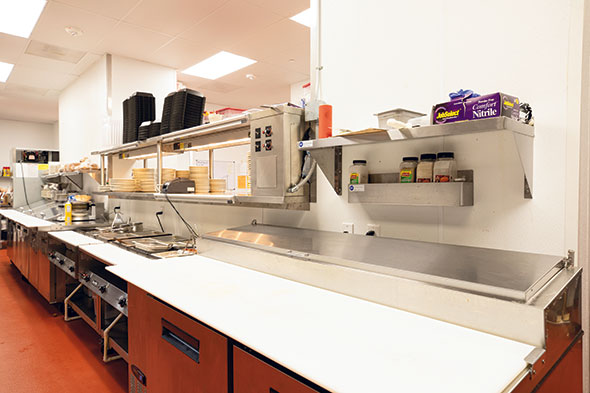Editor's note: Toasted Yolk went to Facebook on March 18 to communicate its COVID-19 operating plans.
In 2010, Matthew DeMott and Chris Milton left their safe, stable jobs with Luby’s restaurant chain to start their own restaurant. The move, DeMott acknowledges, was a gamble. Both had young, growing families at the time, and to finance the venture, they relied on savings and even pulled money out of their retirement accounts.
While this sounds like a recipe for disaster — and it surely has been for others — in this case, the bet paid off. In 2010, The Toasted Yolk Café, a breakfast concept that would allow the partners to spend more time with their families, opened its doors in suburban Houston.

While some lean times followed, that operation stabilized and eventually justified opening a second store in 2013, followed by a third in 2017. Today the chain has six company-owned locations and five franchised units, with many more on the way.
Planned Business
One key to the chain’s success, says DeMott, Toasted Yolk’s president, was a solid business plan, one that “cobbled together” enough dayparts and client groups to make the business viable.
Take the chain’s bar offerings as an example. From the beginning, Toasted Yolk has offered alcohol, first just beer and wine and now a full bar. Though alcohol sales only account for 9 percent of the company’s revenue, the bar menu draws in parties large and small. Many of these groups, DeMott believes, wouldn’t come in without the adult beverage option. “If my wife and I were going to brunch and the place we were looking at didn’t have the ability to serve me a Bloody Mary or mimosa, I’d scratch that place off of the list,” he says.
The chain has a similar get-them-in-the-door attitude toward dayparts. While Toasted Yolk is a breakfast place, it’s not just a breakfast place. The chain also offers a full lunch menu, including a burger, hot sandwiches such as a Rueben and French dip, cold sandwiches like chicken salad and a club sandwich, and about half a dozen salads.
This diversity represents a key ingredient in the company’s success, DeMott says. By developing a strong lunch business, starting with frequent breakfast guests who eventually “turned the menu over,” the chain has pulled in enough business to survive and now thrive.
 Toasted Yolk’s leaders describe the chain’s look as upscale urban, with limited wall decor, a bright feel and a relaxed atmosphere.
Toasted Yolk’s leaders describe the chain’s look as upscale urban, with limited wall decor, a bright feel and a relaxed atmosphere.
The company also invests significantly in food quality. In addition to breakfast staples like pancakes and eggs, the chain offers several elevated menu items that consumers will not find at a typical diner. These include variations of eggs Benedict. Known as “Arnolds” in Toasted Yolk lingo, these menu items feature ingredients like salmon and chicken tenders.
Such offerings help the chain develop loyal customers and even got the first location through some lean times when the road leading to the restaurant was under construction and severely congested. “[Our customers] would make that trip for us; they would weather that storm because of the crave-ability factor,” says DeMott.
The quality of the ingredients also enhances the crave-ability factor at Toasted Yolk. From the beginning, the chain has used higher-end ingredients, like $8-a-gallon orange juice and 10-slice-per-pound bacon. This not only makes the food better, it also gives Toasted Yolk some operational wiggle room. “If you start with a far superior product, if [an order comes out] two minutes later than it should, the quality is upheld,” says DeMott. “If you start with low-quality ingredients, then your margin for error is tiny. We started out with super high-end ingredients, and it paid off. Quality doesn’t cost — it pays.”
Built for Speed
While the chain has built some wiggle room into its operations, it of course works to ensure that food doesn’t take any longer to serve than necessary. While every restaurant wants to keep its ticket times down, Toasted Yolk invests in a supersized kitchen to ensure culinary staff quickly complete orders. All told, Toasted Yolk’s hot line measures about 30 feet, with a matching cold line and separate prep area to boot.
“It’s a larger kitchen than most people think we need, and maybe it is. But when we started this, we wanted to have ticket times between eight and ten minutes,” DeMott says. “We didn’t care if it was Mother’s Day or an off Tuesday at 9 a.m. We accomplish that by being very segmented with our line setup.”
The chain’s production starts with the egg and omelet station. On the cold side of the station, facing the expo window, first comes an upright refrigerator holding backup eggs and milk, then a 72-inch pizza table with omelet ingredients and backups below.
The station’s hot side has two six-burner ranges on stands. Here, one to two staffers, depending on customer volume, make all the chain’s egg-based menu items in 10-inch saute pans. The chain uses a stove instead of a flattop — the short-order standard — in order to execute its whipped omelets with ingredients incorporated into the eggs, DeMott says.
 The chain relies primarily on flattops to cook both its breakfast and its lunch menu. This builds redundancy into its operations.
The chain relies primarily on flattops to cook both its breakfast and its lunch menu. This builds redundancy into its operations.
Supporting this station is a custom-made mobile rack with an ice well. This unit holds the chain’s omelet egg base, whipped fresh every morning, and either rolls into a spot on the hot line or sits next to the line cook, depending on how much room is available. At the end of the day, the rack and pans are simply rolled to the back for cleaning.
Following the omelet station is the breakfast meat station. This space consists of a three-foot flattop for bacon and sausage, then a one-foot flattop for salmon. Both sit on top of a low-boy cooler holding the proteins. Notably, Toasted Yolk parbakes its bacon in ovens before it goes into this lowboy. Given the thickness of its bacon, says DeMott, it would be impossible to cook the meat from raw on a flattop and still maintain eight- to ten-minute ticket times.
 A large pizza table holds all the ingredients for Toasted Yolk’s omelets. Staff cook these — and all egg items — on two six-burner ranges on the hot line.
A large pizza table holds all the ingredients for Toasted Yolk’s omelets. Staff cook these — and all egg items — on two six-burner ranges on the hot line.
After the breakfast meats flattops is another flattop unit on a stand, this one measuring 48 inches. This station is manned by a line cook in charge of pancakes and French toast. The staffer at this station has a rolling mobile rack like the one used at the egg/omelet station. This piece holds batters in ice wells and sits either next to the staffer or is rolled into the hot line, depending on the kitchen’s footprint.
Next comes Toasted Yolk’s fryers, which mark the middle of the hot line. To avoid cross-contamination and flavor mixing, the chain has two units, one dedicated to donuts and the other to chicken tenders.
Past the fryers sits yet another flattop, also at 48 inches and on a stand. This is a second pancake/French toast unit that’s primarily an investment in ticket times, DeMott says. “That third flattop, we don’t even fire up during the week. We put it there for Friday/Saturday/Sunday and holidays so that we don’t lose that speed of service.”
Past the extra pancake griddle is yet another flattop unit. This one is dedicated to lunch items, particularly hot sandwiches. This unit sits on a low-boy holding proteins like burger patties, chicken breasts and turkey for turkey Reubens. Rounding out the hot sandwich station is a sandwich table on the cold line 180 degrees away. At this station, staffers finish hot sandwiches and assemble cold ones, like the chicken salad.
Past the sandwich flattop is the final piece on Toasted Yolk’s hot line, a double-stack convection oven. Here, staff bake hash brown casserole along with chicken breasts for sandwiches and salads, as well as parbakes its bacon.
While a couple of the stations — omelet, sandwich — have equipment on both the hot and cold sides of the line, there are some pieces on the cold side that stand alone. On the far end of the cold line, past the sandwich table, is a salad megatop, while the middle of the cold line is filled out by a steam table holding oatmeal, grits and hash brown casserole.
In addition to the production kitchen, Toasted Yolk has a separate prep area. In addition to worktables, this space has a gravity slicer that staff use to slice deli meats, as well as a 30-quart floor mixer, used to whip eggs, mix hash brown casserole ingredients together for baking and make pancake batter.
Prep at Toasted Yolk starts each morning around 6 a.m. with two managers. One fires up the hot line and begins making oatmeal, gravy (for biscuits and gravy) and grits. The other oversees the cold line quality control and prep planning.
“They’re tossing out bad product and making notes of what needs to be done to get to par levels. Based on the prep needs, the first prep person will start on what we produce daily,” DeMott says. The exception to this, he notes, is the sandwich/salad prep. Since lunch service doesn’t start until 10:30 a.m., the staffer on that station gets in around 8 a.m. to handle ingredients for that area. This staffer is responsible for determining how much he or she needs to prep.
“It is really hard to find a worker who wants to come in for just three hours and then go home. By letting the sandwich and salad person be their own prep person, there is a level of accountability, and it gives them a good seven- or eight-hour workday five days a week,” DeMott says.
Something Tangible
Toasted Yolk’s kitchen is a closed space, with one door for entry and another for exit. DeMott describes the guest environment as industrial urban. Key elements of this look include a dropped ceiling with exposed ductwork along with brick accent walls. “I want it to feel upscale but not stuffy,” he says. “It’s OK to come in flip-flops. We want you to feel relaxed. But it’s not country. No roosters or tractors.”
The island bar becomes the centerpiece of the restaurant. Located front and center, this space serves as a nice option for solo diners and gives guests on the waitlist a chance to order a drink while they wait.
Overall, the restaurant has a light, bright atmosphere, DeMott adds, with an outdoor patio, a signature bright green and plenty of windows. Wall decor is intentionally limited, with a hand-painted mural serving as a notable exception.
This appearance, it should be noted, was only developed starting with the chain’s third restaurant. The first two were built on shoestring budgets, with DeMott and co-founder/CEO Milton laying tile and handling the electrical work themselves. Hiring interior designers just wasn’t in the cards. Creating this new design, though, has been essential to the chain’s rapid growth over the past three years.
“In order to have a sellable, marketable product, you have to have something tangible,” DeMott explains. “People can come see it, put their hands on it, eat the food. The first two locations are near and dear to our hearts, but we knew that they were not Texas-wide stampable, so we got the design team and architects involved.”
Since the development of this new design, Toasted Yolk’s growth has taken off. After opening 2 stores in about 7 years, it opened 4 more in 18 months. Today, the 11-unit chain is on track to have 25 restaurants by the end of next year. Much of this growth will come through franchising, DeMott says, with several markets in Texas either in negotiations, in development or under construction. The chain will make its first moves out of the Lone Star State with a franchised agreement signed for Palm Beach Gardens, Fla.
From there, growth will likely continue in Texas and expand in new areas of Florida. In fact, the company already has a strategy to build a business in a new sector of the Sunshine State: The region needs at least four stores to reap the benefits of a chain operation, with the general manager of the first company-owned restaurant tabbed as a future regional manager once those additional locations open. The chain will also likely hire a regional franchise director to oversee any additional franchised stores in that market.
There’s certainly more to Toasted Yolk’s plan than just a store count and a couple of key employees. Given the business’s successful strategizing to date, there’s good reason to believe Toasted Yolk’s recent growth is just the beginning of its run.
Toasted Yolk at a Glance
- Key players: Chris Milton, co-founder and CEO; Matthew DeMott, co-founder and president
- Interior designer: Interplan LLC
- Kitchen design consultant: Texas Metal Works
- Equipment dealer: Texas Metal Works
Facts of Note
- Chain headquarters: Houston
- Year founded: 2010
- Signature menu items: The Toasted Yolk (sourdough bread grilled with an egg in the middle); West Coast Arnold (two English muffin halves topped with Cajun turkey, bacon, tomato, guacamole, two poached eggs and Cholula ranch); churro-style donuts
- Number of units: 11 currently open, 3 set to open in early 2020; 17 additional units in development phases
- Unit size: 4,400 to 4,800 sq. ft.
- Seats per unit: 120 to 130 interior, 20 to 40 patio
- Location type: Traffic-facing power centers (preferred), town centers, freestanding
- Total system sales: $21 million in 2020
- Average unit sales: $1.5 million
- Growth projections: 19 units by the end of 2020, 25 by the end of 2021
- Check average: $33.62
- Equipment package cost: $225,000




